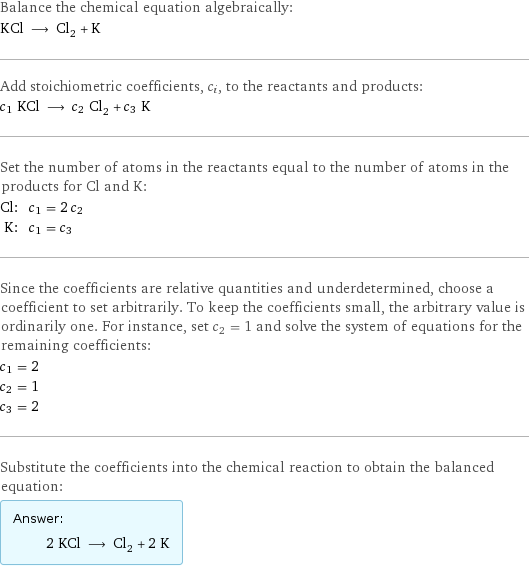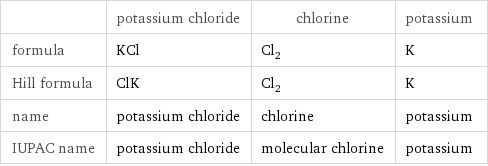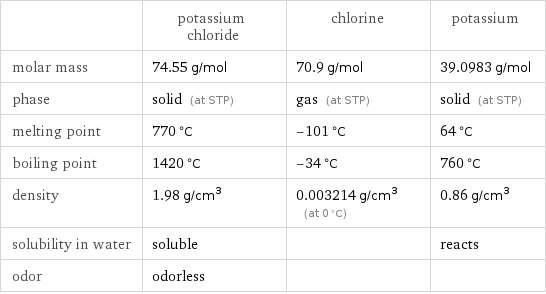Input interpretation

KCl potassium chloride ⟶ Cl_2 chlorine + K potassium
Balanced equation

Balance the chemical equation algebraically: KCl ⟶ Cl_2 + K Add stoichiometric coefficients, c_i, to the reactants and products: c_1 KCl ⟶ c_2 Cl_2 + c_3 K Set the number of atoms in the reactants equal to the number of atoms in the products for Cl and K: Cl: | c_1 = 2 c_2 K: | c_1 = c_3 Since the coefficients are relative quantities and underdetermined, choose a coefficient to set arbitrarily. To keep the coefficients small, the arbitrary value is ordinarily one. For instance, set c_2 = 1 and solve the system of equations for the remaining coefficients: c_1 = 2 c_2 = 1 c_3 = 2 Substitute the coefficients into the chemical reaction to obtain the balanced equation: Answer: | | 2 KCl ⟶ Cl_2 + 2 K
Structures

⟶ +
Names

potassium chloride ⟶ chlorine + potassium
Reaction thermodynamics
Entropy

| potassium chloride | chlorine | potassium molecular entropy | 83 J/(mol K) | 223 J/(mol K) | 64 J/(mol K) total entropy | 166 J/(mol K) | 223 J/(mol K) | 128 J/(mol K) | S_initial = 166 J/(mol K) | S_final = 351 J/(mol K) | ΔS_rxn^0 | 351 J/(mol K) - 166 J/(mol K) = 185 J/(mol K) (endoentropic) | |
Equilibrium constant
![Construct the equilibrium constant, K, expression for: KCl ⟶ Cl_2 + K Plan: • Balance the chemical equation. • Determine the stoichiometric numbers. • Assemble the activity expression for each chemical species. • Use the activity expressions to build the equilibrium constant expression. Write the balanced chemical equation: 2 KCl ⟶ Cl_2 + 2 K Assign stoichiometric numbers, ν_i, using the stoichiometric coefficients, c_i, from the balanced chemical equation in the following manner: ν_i = -c_i for reactants and ν_i = c_i for products: chemical species | c_i | ν_i KCl | 2 | -2 Cl_2 | 1 | 1 K | 2 | 2 Assemble the activity expressions accounting for the state of matter and ν_i: chemical species | c_i | ν_i | activity expression KCl | 2 | -2 | ([KCl])^(-2) Cl_2 | 1 | 1 | [Cl2] K | 2 | 2 | ([K])^2 The equilibrium constant symbol in the concentration basis is: K_c Mulitply the activity expressions to arrive at the K_c expression: Answer: | | K_c = ([KCl])^(-2) [Cl2] ([K])^2 = ([Cl2] ([K])^2)/([KCl])^2](../image_source/c04ed10a55082046be516c00fc159f30.png)
Construct the equilibrium constant, K, expression for: KCl ⟶ Cl_2 + K Plan: • Balance the chemical equation. • Determine the stoichiometric numbers. • Assemble the activity expression for each chemical species. • Use the activity expressions to build the equilibrium constant expression. Write the balanced chemical equation: 2 KCl ⟶ Cl_2 + 2 K Assign stoichiometric numbers, ν_i, using the stoichiometric coefficients, c_i, from the balanced chemical equation in the following manner: ν_i = -c_i for reactants and ν_i = c_i for products: chemical species | c_i | ν_i KCl | 2 | -2 Cl_2 | 1 | 1 K | 2 | 2 Assemble the activity expressions accounting for the state of matter and ν_i: chemical species | c_i | ν_i | activity expression KCl | 2 | -2 | ([KCl])^(-2) Cl_2 | 1 | 1 | [Cl2] K | 2 | 2 | ([K])^2 The equilibrium constant symbol in the concentration basis is: K_c Mulitply the activity expressions to arrive at the K_c expression: Answer: | | K_c = ([KCl])^(-2) [Cl2] ([K])^2 = ([Cl2] ([K])^2)/([KCl])^2
Rate of reaction
![Construct the rate of reaction expression for: KCl ⟶ Cl_2 + K Plan: • Balance the chemical equation. • Determine the stoichiometric numbers. • Assemble the rate term for each chemical species. • Write the rate of reaction expression. Write the balanced chemical equation: 2 KCl ⟶ Cl_2 + 2 K Assign stoichiometric numbers, ν_i, using the stoichiometric coefficients, c_i, from the balanced chemical equation in the following manner: ν_i = -c_i for reactants and ν_i = c_i for products: chemical species | c_i | ν_i KCl | 2 | -2 Cl_2 | 1 | 1 K | 2 | 2 The rate term for each chemical species, B_i, is 1/ν_i(Δ[B_i])/(Δt) where [B_i] is the amount concentration and t is time: chemical species | c_i | ν_i | rate term KCl | 2 | -2 | -1/2 (Δ[KCl])/(Δt) Cl_2 | 1 | 1 | (Δ[Cl2])/(Δt) K | 2 | 2 | 1/2 (Δ[K])/(Δt) (for infinitesimal rate of change, replace Δ with d) Set the rate terms equal to each other to arrive at the rate expression: Answer: | | rate = -1/2 (Δ[KCl])/(Δt) = (Δ[Cl2])/(Δt) = 1/2 (Δ[K])/(Δt) (assuming constant volume and no accumulation of intermediates or side products)](../image_source/b4e62f53fab71d550a0f7ce92a6013a6.png)
Construct the rate of reaction expression for: KCl ⟶ Cl_2 + K Plan: • Balance the chemical equation. • Determine the stoichiometric numbers. • Assemble the rate term for each chemical species. • Write the rate of reaction expression. Write the balanced chemical equation: 2 KCl ⟶ Cl_2 + 2 K Assign stoichiometric numbers, ν_i, using the stoichiometric coefficients, c_i, from the balanced chemical equation in the following manner: ν_i = -c_i for reactants and ν_i = c_i for products: chemical species | c_i | ν_i KCl | 2 | -2 Cl_2 | 1 | 1 K | 2 | 2 The rate term for each chemical species, B_i, is 1/ν_i(Δ[B_i])/(Δt) where [B_i] is the amount concentration and t is time: chemical species | c_i | ν_i | rate term KCl | 2 | -2 | -1/2 (Δ[KCl])/(Δt) Cl_2 | 1 | 1 | (Δ[Cl2])/(Δt) K | 2 | 2 | 1/2 (Δ[K])/(Δt) (for infinitesimal rate of change, replace Δ with d) Set the rate terms equal to each other to arrive at the rate expression: Answer: | | rate = -1/2 (Δ[KCl])/(Δt) = (Δ[Cl2])/(Δt) = 1/2 (Δ[K])/(Δt) (assuming constant volume and no accumulation of intermediates or side products)
Chemical names and formulas

| potassium chloride | chlorine | potassium formula | KCl | Cl_2 | K Hill formula | ClK | Cl_2 | K name | potassium chloride | chlorine | potassium IUPAC name | potassium chloride | molecular chlorine | potassium
Substance properties

| potassium chloride | chlorine | potassium molar mass | 74.55 g/mol | 70.9 g/mol | 39.0983 g/mol phase | solid (at STP) | gas (at STP) | solid (at STP) melting point | 770 °C | -101 °C | 64 °C boiling point | 1420 °C | -34 °C | 760 °C density | 1.98 g/cm^3 | 0.003214 g/cm^3 (at 0 °C) | 0.86 g/cm^3 solubility in water | soluble | | reacts odor | odorless | |
Units
